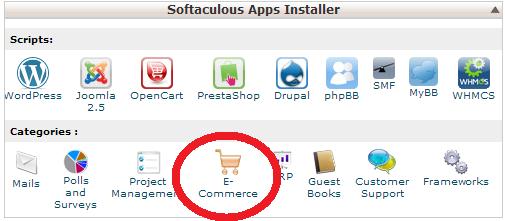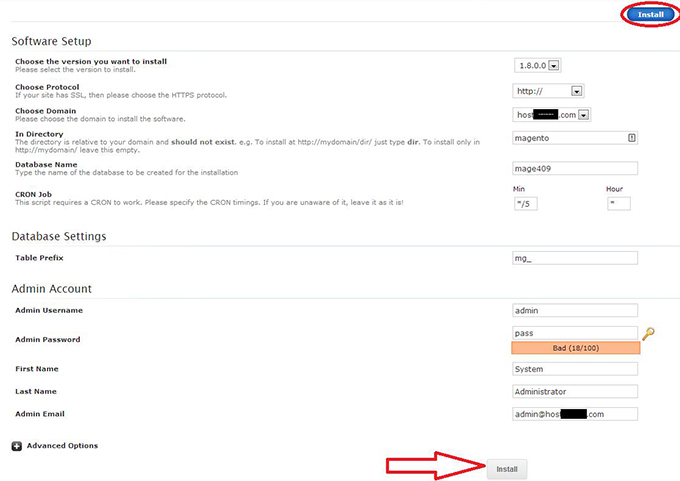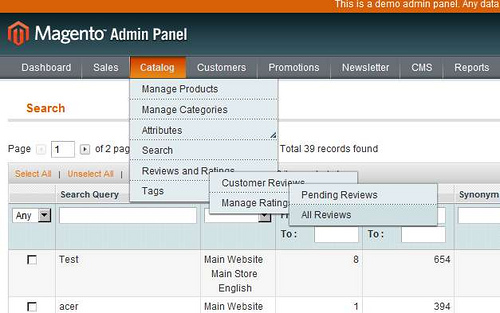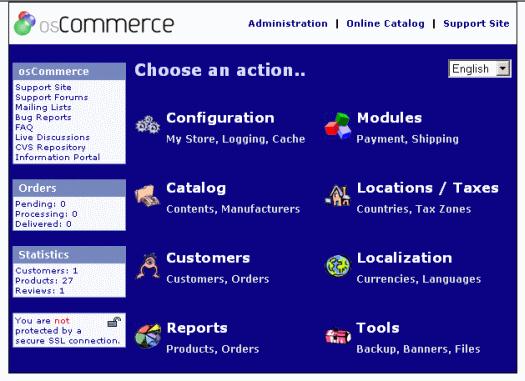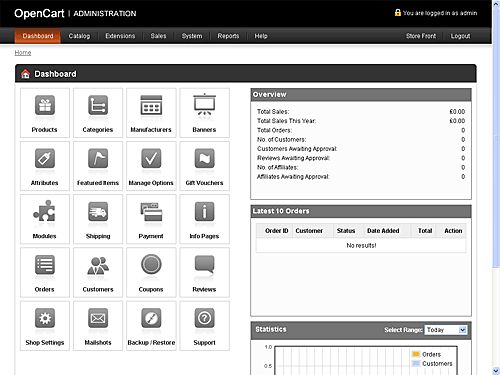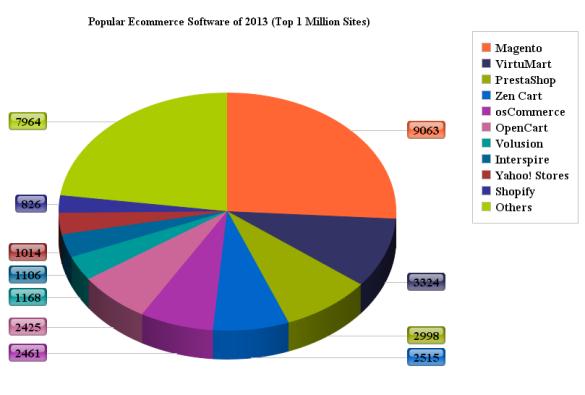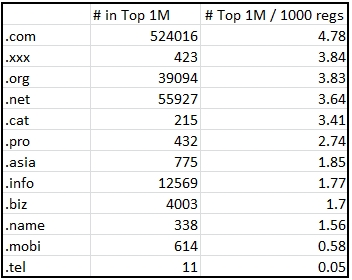Some time ago an online store was something that only a skillful programmer could develop and something that only a big company could maintain. But the Internet has changed and now any seller can have it. CMS (content management system) is basically a kind of software which develops and maintains it for you. As there are many of them, let’s first try to draw a short classification:
– Free open source CMS. (Open source stands for editable source code and not for zero cost. However, as 99% of open source CMS are free, they are now used as synonyms). This is a natural solution not only for beginners but for any web store with more or less standard structure and no ‘special’ needs. Among popualr CMS of this kind one may find osCommerce, Magento and Zen Cart. Also there are shopping cart plugins for such widely used CMS as WordPress and Joomla. Important note – while a platform itself may be free, some of the addons or plugins may be commercial. Same applies to custom themes: if you need one, you will need to purchase it.
– Paid CMS. Strong point of this group is that they often do not require buying web-hosting as a separate service (so called pre hosted solutions) and often have better support than the free ones. Also paid CMS are claimed to be more secure due to the fact that providers are responsible for keeping them up-to-date. Weak point is that ‘standard structure and no special needs’ rule applies to them as well. Here we can name Shopify and Foxycart. Usually providers of such CMS offer free trial periods, so you can test the service (e.g. 14 days period with Shopify).
– Custom CMS. This is when a team of developers is creating a unique platform for your shop special requirements (both for design and functionality). Such a solution may be efficient for a big company but will be too expensive and too complicated for a small business. A trick here is that you will have to use the same developers for further support and modifications (it is unlikely that a third party specialist can sort out their code). We won’t name any particular products here as they are all unique.
Now when we have classification let’s take a closer look at the case when you have web-hosting for your site and looking for a simple e-commerce solution. If your hosting provider is offering cPanel with Softaculous installer integrated (true for most providers and most of shared packages but not for all), then you have a good bunch of such solutions at hand with E-Commerce button:
The amount of different scripts there is so big that you would rather *not* need to look for alternatives elsewhere. In the list you can find osCommerce, Magento, OpenCart, PrestaShop and several others. If you are selling virtual services such as web-hosting and domain names, there is also WHMCS which has proved to be one of the best billing systems for this purpose (it is not free though, you need to buy license first). The installation process with Softaculous is simple and contains of one step (at the picture you can see installation screen for Magento but it will be very similar for any other script):
After the installation you are done with Softaculous and can start working with the CMS directly. Control panels are very different but mostly they are all designed to be user-friendly and not requiring special skills to work with them. For example, here is a look at Magento control panel:
For comparison, let’s look at the osCommerce and OpenCart main menu screens:
If taking these three CMS (Magento, OpenCart and OSC), they are all free (you may need to purchase addons if needed though), efficient and easy to deal with. However, many users claim that Magento is consuming more resources (and so you may need a stronger hosting package to maintain it) and OSC requires more modifications to make it work the way you need it to work. Also, Magento is believed to work best with big stores, while OpenCart and OSC may be more efficient for a small business. Still, opinions may differ and all platforms have their fans.
Another important matter for e-commerce CMS is security. While many people are arguing which one is more secure and if an opensource platform can be secure at all, specialists report that safety of your store rather depends on how careful *you* are. Main recommendations (regardless of CMS name) are using strong passwords, non-default directories for installation and making sure you always have an up-to-date version of the product. Other suggestions concern using SSLs, encrypting customers’ passwords and keeping a fresh backup at hand.
As a conclusion, we must say that there is no ideal CMS for your store, but there can be one meeting your needs best. This chart of e-commerce CMS popularity may also help you to make the choice:
If you are looking for a platform for your store, take a look at our cheap unlimited VPS offers.
If your business isn’t online then you are not in business
(Bill Gates)
If your business needs to go online (it doesn’t matter if we are talking about a one-page site or a powerful web-portal) then it also needs a domain name. How to choose it right then?
First, you need to choose a TLD (stands for Top Level Domain, often it’s called an extension) – a part which goes after dot, e.g. .com, .net or .us. If your target customers are of a one particular country, then a country TLD will work, e.g. .us for American customers. A site with such an extension will be taking a higher position in search results for this region. If international audience is expected (maybe in future, not necessarily now), then choose .com. First, it will have positive influence on speed and quality of search engine indexation. Second, this TLD is the most popular and recognizable. Even big companies are interested in getting .com domains for their projects (let’s take recent dispute for wiiu.com between Nintendo and Eurogamer). Think of ten web-sites which first come to your mind – surely either all or most of them will be .com. For statistics, let’s look at the table below. The second column contains total amount of the sites with a certain TLD which are in the top 1,000,000 popular pages in the web. The third one contains average amount of the sites in the top 1,000,000 for a thousand of registered names. The data is supplied by Alexa monitoring service:
When choosing something less popular (e.g. .net) or something exotic (let’s take .me), you are at two risks. First, a part of your earned traffic will go to the identical .com domain anyway and so will be lost. Second, you may suddenly discover that the TLD you have selected has some restrictions or pitfalls. For example, it is not allowed to run commercial websites in this zone at all (true for .info and .org).
The second step is choosing the domain name itself. If you company is called Big Tomato (for example), then you may choose bigtomato.com (or bigtomato.us if you sell your tomatoes in the US only)… and discover that it is taken long ago! No need to panic. And no need to choose a different extension (see previous paragraph). If your business is focused on a specific region then you can add a name of the region to the domain, e.g. bigtomato-ny.com. Also it’s OK to add a word characterizing the very type of the business, e.g. bigtomato-cafe.com (if your company is a café). Generally, a domain name should be memorable, easy-to-pronounce and easy-to-type.
Now what you should NOT do when choosing a domain name:
– Do not translate the name of your company or trademark from national language into English or vice versa. A name is a name and it must sound identical in all languages.
– Do not abuse hyphens and avoid digits. Big-t-o-m-a-t-o.com may look attractive but it won’t work as an easy-to-type address, while bigtomato-2013.com looks (and actually is) totally unprofessional.
– An acronym is also not a good idea. Your goal should be to make the domain memorable and it is easier to remember full words than a row of letters. Domain names like fprstb.com must have originated from the desire to make the name as short as possible, but let’s avoid extremes. Too short is almost as bad as too long. In our opinion from 10 to 20 symbols is fully adequate for a business domain.
– Do not accepts offers to purchase a registered domain name from a reseller instead of registering a new one. Though multiple marketplaces (the most known is Sedo), auctions and so-called aftermarkets may offer a beautiful and old domain, the price will be unfair and the advantages of such a domain won’t be very essential.
And the very last point. If you have a SEO specialist, this is a must to consult him before registering your domain name, because SEO and a domain name are related things. And remember that it is impossible to edit a registered domain and accidental typos may result in serious problems, so be careful in the registration process.
If you have already decided on the domain for your business, don’t forget to take a look at our web hosting for small business offers or big projects. If you think that shared hosting is not enough for your website, take a look at our cheap VPS servers we offer.
The factor that keeps boosting the Internet in general and hosting business in particular is that starting a new website has become a really easy thing that literally everyone can do now. One no longer needs to be a smarty-pants with a degree in computer science in order to kick off an online project. It is also possible that such project, run by a fast learning newbie, will stay on par with projects run by more experienced rivals and will neither fall short of design quality nor lack in functionality. Why? The answer is: one does not need to write website code from scratch anymore. In fact, one may not need to write the code at all. There are dozens of free open-source content management systems (CMS) which can be used right after 5-minute installation as well as allow plenty of modules, extensions and other customization tools that can be additionally installed and used later on. WordPress, Joomla, Drupal are the most popular (although the list is by no means exhaustive – many other CMSs are widely used and loved). Each of them has its fans, several hundred pages thick manuals and millions of websites run on them.
Today we will show how to install Drupal on cPanel. Why Drupal? Well, it is just as good as WordPress so the choice is more like a matter of taste and experience than “what is better”. Moreover, the installation process of one CMS is very similar to that of the others (which is but natural).
Drupal is a highly reliable enterprise-level content management system which went as far as being used for development of websites of the White House, NASA, the New York State Senate and many others governmental, commercial and non-profit organizations all over the world. It is distributed under GNU General Public License and therefore can be copied, modified, studied and used freely.
So, let’s start. First of all, we need to go to Drupal website https://drupal.org/download and download the archive. Now there are the following versions available: 4.x, 5x, 6x, 7x and 8x (alpha version). We will install Drupal 7.23 as it is the latest stable version so far. Unzip the archive. There should be a directory “drupal-7.23” with files and subdirectories (/modules, /profiles, /scripts, etc.).
Launch an FTP client (e.g. FileZilla) and connect to your ftp account. If you want to install the CMS for the main domain of the cPanel account, you can use your cPanel username as the FTP username and the cPanel password as the FTP password. If you want to install it for addon domain you need to use the password you have previously set for it and the username which looks as follows: addon@domain.com (where “addon” is the username for the addon domain and “domain.com” is the main domain of the cPanel account). You can find the addon domain username at cPanel > Addon Domains > Username column. The ready-to-use FTP username can be found at cPanel > Files > FTP Account > FTP Accounts.
Upload the contents of the “drupal-7.23” directory to the server. Alternatively, you can use cPanel File Manager for uploading the content (cPanel > Files > File Manager > Upload). Then go to http://domain.com/install.php. This will start the installation process.
Choose Standard profile, language, and verify the requirements. If this is your first website on the server, and Apache and PHP have not been configured manually before, some Apache modules or PHP extensions might be missing. In this case there will be a warning on the pink background. In order to add the necessary modules and extensions you should use the special WHM/cPanel tool called EasyApache. Go to WHM > Software > Easy Apache, choose the first “default” profile, click “Start customizing based on profile”, select Apache and PHP version (if Apache and PHP versions have passed Drupal pre-installation check you should not change the already set versions). On the Short Options List and Exhaustive Options List you need to select the missing modules and extensions, and finally click “Save and build”.
The recompilation may take from 10 to 30 minutes.
Once recompilation is complete, return to the Drupal installer and go to the next step, that is setting up the database.
In order to set up the database, you need to create an “empty” database, a database user, assign the database to this user and set the permissions. Go to cPanel > Databases > MySQL Databases > Create New Database, enter the database name and click Create Database.
Having done that, create a new database user and set the user password.
Finally, add the user to the database
and set the permissions (ALL PRIVILEGES).
Return to the Drupal installer, choose “MySQL, MariaDB, or equivalent”, fill in the text boxes and click “Save and continue”.
Congratulations! You have just installed Drupal. All that is left is to configure the website. You need to enter the site name, the site email address, set up an admin account and choose other settings.
Looking for hosting for your website? Take a look at our cheap vps server hosting offers.
 So, what is the first thing to do if your personal page (or, God forbid, important corporate website) suddenly gets down. For an average user the answer seems clear enough – contact support. However, several quick steps of basic diagnostics can help you to identify the issue and speed the process up or sometimes even resolve it yourself. Read the rest of this entry »
So, what is the first thing to do if your personal page (or, God forbid, important corporate website) suddenly gets down. For an average user the answer seems clear enough – contact support. However, several quick steps of basic diagnostics can help you to identify the issue and speed the process up or sometimes even resolve it yourself. Read the rest of this entry »
 w
w
Command w displays list of the currently logged in users and some additional information. If you want to check who else is connected to your server and what they are doing, w is the command you need.

